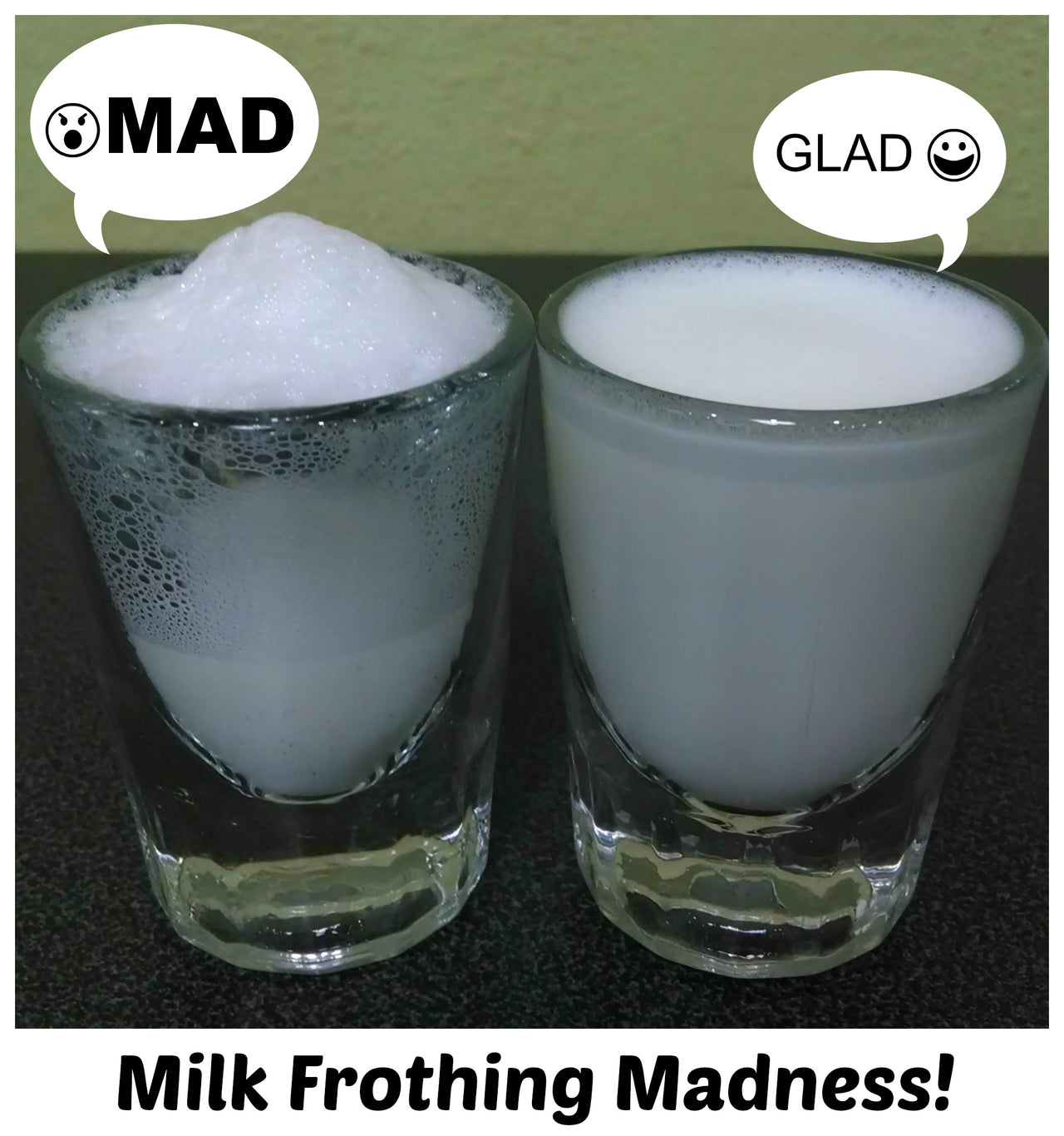How many how-to-froth-milk videos have you watched? They make it look so easy! While my espresso shots are really improving, I still have a hard time getting milk to the right consistency for a perfect latte. My lack of consistent consistency makes me a little grumpy...even mad. If frothing milk makes you grumpy too, then follow along as I try to de-mystify microfoam. It is time for FROTHING MADNESS!
First things first, while you can use the words froth and foam interchangeably, what we are after is the ever elusive microfoam. The manner in which milk is heated produces different results. Microfoam is smooth and velvety with a texture almost like wet paint because very tiny bubbles are incorporated evenly throughout the liquid. The foam I most often produce is heated milk with a bubbly volcano of erupted meringue dolloped on top. This is not microfoam.
The more you practice on one home espresso machine, the more you get to know the timing involved. This is one of my problems. I froth milk on different machines. Teri in customer service tried to console me. She said, “just when you thought you had steaming down on one machine, you try another machine and it steams totally different! ...or someone changes your steam tip from a two-hole to a four-hole!” (Which totally happens around here but probably doesn’t happen at your house.)
You are probably familiar with the basics of milk frothing:
- Start with a chilled stainless steel milk frothing pitcher and cold milk.
- Submerge the steam wand, start to froth, then lower the pitcher until just the steam tip is submerged. The milk should move in a circular pattern.
- Plunge the wand lower into the pitcher and continue to roll the milk.
- Stop at your desired temperature.
While this sounds well and good, let’s explore how this works in real-life situations with three very different home espresso machines. Armed with some additional tricks from my barista friends, we can learn together!
Rocket Giotto Evoluzione -
A heat exchanger espresso machine with a large 60oz boiler
Espresso machine repair tech, Bryan, gave me some great advice. First, whole milk froths best. Second, on a larger espresso machine like this one, plunge the wand a few seconds sooner than you think it will take. It only took 35 seconds to froth 6 ounces of milk to 165F. I found this out the hard way because at 40 seconds it was up to 170F and the milk smelled scalded. Because it happens so fast, it is hard to make adjustments. I grabbed a gallon of milk and kept trying until I got it just right.
Breville Infuser -
A home espresso machine with a thermoblock
Matthew Hodson, a Seattle-area professional barista, shared this via Twitter “Experiment to find the spot where the milk and foam spin in a whirlpool and integrate. Only aerate briefly (count 1,2,3 quickly) and then spend the rest of the time integrating with the whirlpool.” It took 1:15 to get 6 ounces of milk to 165F. This was enough time to experiment with different adjustments. With some extra time and careful attention spent tilting and pivoting the frothing pitcher around the steam wand, this technique produced good results.
Saeco Via Venezia -
A single boiler with less than 8oz capacity
To get quality milk frothing from a smaller espresso machine requires every trick in the book. Make sure the espresso machine is on and pre-heated. Clear the steam wand (or in this case the panarello) into the drip tray until it is all steam with no water. Note where the air intake hole is on the panarello sleeve and keep it even with the level of the milk in the pitcher, not above or below. Froth one drink at a time, in this case 6 ounces took 1 minute to steam but was still very bubbly.
Lastly, Miranda in customer service told me you can try to “fix” milk frothing madness by softly tapping the frothing pitcher on the counter and swirling it in a circle repeatedly to try to eliminate big bubbles and incorporate the little bubbles back into the mix. Don’t try to re-heat or re-froth the milk. When all else fails keep these two important adages in mind,
1)
Don’t cry over spilt milk
2)
Tis a lesson you should heed, If at first you don't succeed, Try try again.
